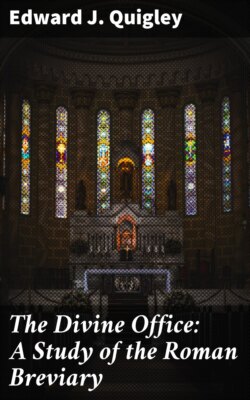Читать книгу The Divine Office: A Study of the Roman Breviary - Edward J. Quigley - Страница 29
На сайте Литреса книга снята с продажи.
THE YEAR AND ITS PARTS.
ОглавлениеThe Council of Trent, Sess. XXIII., c. 18, orders "ut in disciplina ecclesiastica clerici commodius instituantur grammaticas, cantus, computi ecclesiastici, aliarumque bonarum artium disciplinam discant." The minute study of the ecclesiastical calendar is not now so necessary for each priest, as it was centuries ago. The Ordo Divini Officii recitandi, issued yearly, and prepared with great accuracy, relieves priests of much labour and secures them from many doubts. And the decision of the Congregation of Rites (13th January, 1899) regarding the authority of the ordo gives greater security. "Qui probabilius judicat errare Calendarium tenetur eidem Calend. stare, nec potest proprio inhaerere judicio quoad officium, Missam vel colorem Paramentorum." Of course this decision does not apply to errors which are openly and plainly at variance with the rubrics of the Missal and Breviary. However, it may be well to revise and to recall the student days' lessons on the Church's Calendar. The study is not an easy one, and in labouring to be brief, probably, I may be obscure and incomplete.
"Annus menses habet duodecim …" says the Breviary. The year has twelve months, fifty-two weeks plus one day, or 365 days and almost six hours. But these six hours make up a day every four years, and this fourth year is called bisextile.
In making calculations the six hours were taken as six complete hours, and not six hours wanting some minutes. And the aggregate miscalculation continued until the minutes added yearly, amounted to ten days and changed the date of the spring equinox. Pope Gregory XIII. (1572–1585) sought to remedy the error. He re-established the spring equinox to the place fixed by the Council of Nice (787). The year had fallen ten days in arrear from the holding of the Council until the year of the Gregorian correction, 1582. He again fixed it to the day arranged by the Council, the 14th of the Paschal moon. And he arranged, that such a time-derangement should not occur again. He omitted ten full days in October, 1582, so that the fourth day of the month was followed immediately by the fifteenth. He determined that the secular year must begin on 1st January, that three leap years should be omitted in every four centuries, e.g., 1700, 1800, 1900, 2100, and his arrangement has been observed throughout nearly the whole world.
Quarter Tenses fall on the Wednesdays, Fridays, and Saturdays after the third Sunday of Advent, after the first Sunday of Lent; after Pentecost Sunday, and after the feast of the exaltation of the Cross.
The Nineteen Years' Course of the Golden Number. This course or cycle was invented by an Athenian astronomer about 433 B.C. It was not exact, but was hailed with delight by the Greeks, who adorned their temples with the key number, done in gold figures; hence the name. The cycle of course is the revolution of nineteen years, from 1 to 19. When this revolution or course of years is run there is a new beginning in marking, No. 1, e.g., in the year 1577 the nineteenth number, the golden number, was 1; the following year it was 2, and so on until in 1597 the golden number again is 2. A table given in the Breviary shows how the golden number may be found and a short rule for the finding of it in any year is given. To the number of the year (e.g., 1833) add 1; then divide the sum thus resulting by 19 and the remainder is the golden number; if there be no remainder the golden number is 19.
